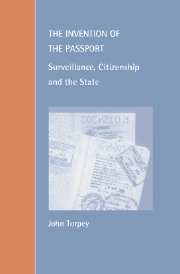Book contents
- Frontmatter
- Contents
- Acknowledgments
- Introduction
- 1 Coming and Going: On the State Monopolization of the Legitimate “Means of Movement”
- 2 “Argus of the Patrie”: The Passport Question in the French Revolution
- 3 Sweeping Out Augeas's Stable: The Nineteenth-Century Trend Toward Freedom of Movement
- 4 Toward the “Crustacean Type of Nation”: The Proliferation of Identification Documents From the Late Nineteenth Century to the First World War
- 5 From National to Postnational? Passports and Constraints on Movement from the Interwar to the Postwar Era
- Conclusion: A Typology of “Papers”
- Notes
- References
- Index
Conclusion: A Typology of “Papers”
Published online by Cambridge University Press: 24 August 2009
- Frontmatter
- Contents
- Acknowledgments
- Introduction
- 1 Coming and Going: On the State Monopolization of the Legitimate “Means of Movement”
- 2 “Argus of the Patrie”: The Passport Question in the French Revolution
- 3 Sweeping Out Augeas's Stable: The Nineteenth-Century Trend Toward Freedom of Movement
- 4 Toward the “Crustacean Type of Nation”: The Proliferation of Identification Documents From the Late Nineteenth Century to the First World War
- 5 From National to Postnational? Passports and Constraints on Movement from the Interwar to the Postwar Era
- Conclusion: A Typology of “Papers”
- Notes
- References
- Index
Summary
I have tried to demonstrate in the preceding pages that identification documents such as passports have played a crucial role in modern states' efforts to generate and sustain their “embrace” of individuals and to use this embrace to expropriate the legitimate “means of movement.” We have witnessed over the last two centuries a shift in the “reach” of documentary controls on movement from relatively small-scale spaces (municipalities) in dynastic states to “national” spaces and, more recently, to the “suprastate” level of the European Union. The documents involved have been critical to state-building activities in that they identify who is “in” and who is “out” in membership terms, and thus help distinguish who may make legitimate claims to the rights and benefits of membership. Here I explicate in greater detail the nature of the different types of such documents and analyze their relationship to states' assertion of a monopoly on the right to regulate people's movements.
Such documents come in three basic varieties. Clearly, (external) passports and internal passports or “passes” are not the same thing, although the former appears to have evolved out of the latter to a significant degree. External or international passports, most familiar today to those from “liberal-democratic” countries, are documents associated with movement across international state boundaries. They ordinarily constitute prima facie evidence of the bearer's nationality. In contrast, internal passports or passes are designed to regulate movements within the jurisdiction of a state.
- Type
- Chapter
- Information
- The Invention of the PassportSurveillance, Citizenship and the State, pp. 158 - 167Publisher: Cambridge University PressPrint publication year: 1999



